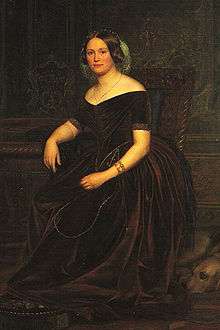Louise Rasmussen
| Louise Rasmussen | |
|---|---|
 | |
| Born |
21 April 1815 Copenhagen, Denmark |
| Died |
6 March 1874 (aged 58) Genoa, Italy |
| Title | Countess Danner |
| Spouse(s) | Frederick VII of Denmark |
| Children | Carl Christian Berling |
| Parent(s) |
Juliane Caroline Rasmussen Gotthilf L. Køppen |
Louise Christine Rasmussen, also known as Countess Danner (21 April 1815 – 6 March 1874), was a Danish Ballet dancer and stage actor. She was the mistress and later the morganatic spouse of King Frederick VII of Denmark. She was not a queen consort, but officially styled Countess Danner.
Biography
Louise Rasmussen was the daughter of the unmarried maid Juliane Caroline Rasmussen and the merchant Gotthilf L. Køppen. She was a student of the ballet school of the Opera in Copenhagen in 1826, was contracted in 1830 and a figurante ballerina in 1835. In 1841, she had a child[1] with the print maker Carl Berling, who was the heir of the paper Berlingske Tidende, one of the most important Danish newspapers. She retired from the ballet in 1842, and opened a fashion shop.
She got to know Crown Prince Frederick through Berling in the 1830s and had a relationship with him during the 1840s. Frederick became king in 1848. He wanted to marry Louise, but the government forbade it, as Frederick was childless and no children born from a marriage with Louise would have been entitled to the throne. The reformed law of 1849, however, made the king so popular that he was able to have his wish granted.
On 8 August 1850, Louise Rasmussen was given the title "Countess of Danner" and was married to Frederick in Frederiksborg Slotskirke by Bishop J. P. Mynster. She was the morganatic spouse of King Frederick, and was thereby not queen, nor did any possible children from the union have any right to the throne. The marriage was met with great dislike and opposition, especially from the upper-class and the nobility, who considered it a misalliance. Louise was met with humiliation and disdain in social circles. On one occasion, for example, Frederick and Louise participated at a grand formal dinner with many members of the highest nobility; at the occasion in question, it was the custom of the nobility to propose a toast to the spouse of the monarch. This time, however, no one proposed a toast, even though Frederick and Louise waited for it to happen. Eventually, Frederick lost his patience, stood up and said openly: "As no one here will propose a toast to my wife, I will do so myself!", after which the nobility finally raised their glasses.[2]
The couple had a secret daughter in 1851, concealed due to complications with the Schleswig-Holstein duchies. The girl was named Mary, and then adopted as Elizabeth Wynn in Wales by cooperation of the British Royalty.[3]
In 1854, the couple bought the manor, Jægerspris Slot, as a place to spend their private life and after Frederick's death in 1863, Louise lived a discreet life there. In 1873, she founded "Frederick the VII:s Foundation for Poor Women from the Working Class", and the house was called "The Danner House". When she died, she left Jægerspris Slot "to the benefit of poor and destitute servant girls" in her last will and testament.
See also
References
- ↑ http://www.thepeerage.com/p628.htm
- ↑ Alf Henrikson: Dansk historia (Danish history) 1989 (in Swedish)
- ↑ Hamilton, Ben. "The lost princess: How the Schleswig- Holstein Question just got even more complicated" The Copenhagen Post, 11 September 2014. Accessed: 13 September 2014.
Further reading
- Jægerspris Slot og Kong Frederik den syvendes Stiftelse af Roar Skovmand, 1974
- Stiftelsestøser - Kongebørn, af Lis Petersen, 1987
- Grevinde Danner - en oprørsk kvinde af Morten Meisner, 1990
- Grevinden af Bodil Wamberg, 2004
- Kvinderummet. Dannerhuset som kvindepolitisk forum og krisecenter af Britta M. Lindqvist, Kari Helene Partapuoli og Lea Holst Spenceley, 2004. Se også hjemmeside om bogen
- Louise længe leve - Maria Helleberg, 1994.
External links
| Wikimedia Commons has media related to Grevinde Danner. |
- Countess Danner at the website of the Royal Danish Collection at Rosenborg Castle